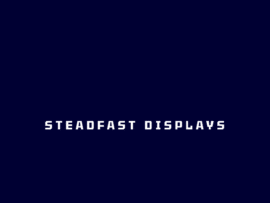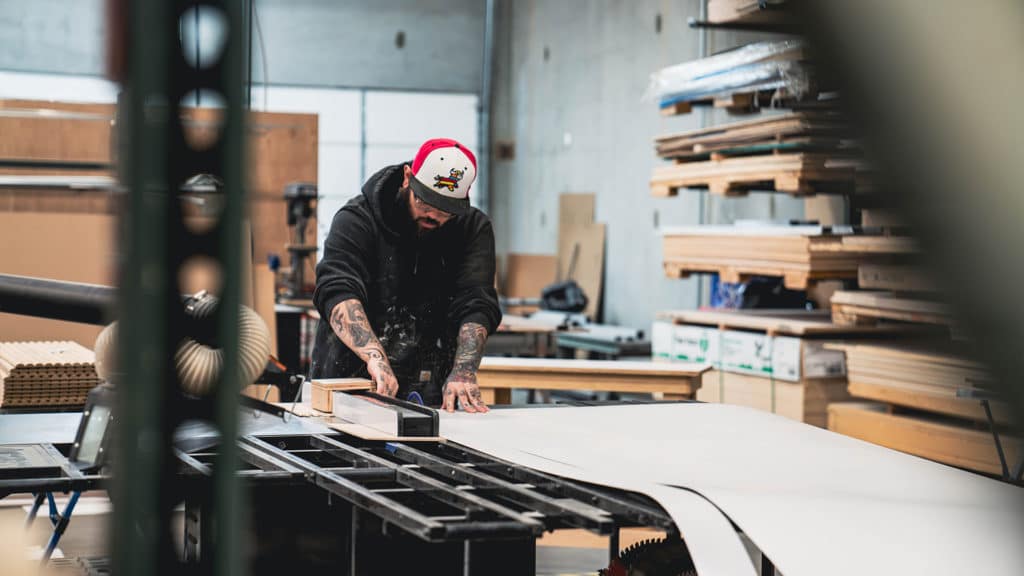When it comes to creating impactful trade show displays, the smallest details often make the biggest difference. While layout and structural design grab the initial attention, it’s the finish that ties everything together, enhancing aesthetics, ensuring durability, and creating a memorable brand statement. Two of the most common finishing options for trade show displays are powder coating and paint. These methods not only serve functional purposes but also influence the overall visual appeal and longevity of the exhibit. At Steadfast Displays, where craftsmanship meets innovation, we understand how critical it is to choose the right finish.
Powder coating and paint each have their strengths, making the decision a crucial step in creating an exceptional display. Understanding the distinct features of these finishes will help you align your choice with the unique requirements of your exhibit and brand vision.
The Role of Finishes in Trade Show Displays
A finish serves as more than just a protective layer; it defines the visual identity and durability of your trade show exhibit. In a competitive event environment, where dozens of brands vie for attention, the appearance of your display can either captivate visitors or leave them unimpressed. The right finish elevates your booth by enhancing colors, adding texture, and improving durability. Trade show displays undergo frequent assembly, disassembly, and transportation, often leading to wear and tear. A robust finish ensures your booth maintains its pristine appearance across multiple events.
For brands aiming to project a specific aesthetic—be it sleek and modern or vibrant and playful—the finish plays an integral role. Finishes also reflect your commitment to quality, subtly communicating to attendees that your business pays attention to every detail.
What is Powder Coating?
Powder coating is a dry finishing process in which powdered pigment and resin particles are applied to a surface using an electrostatic charge. Once applied, the piece is heated in a curing oven, where the powder fuses into a smooth, durable layer. Powder coating is widely known for its longevity, uniform application, and eco-friendly nature.
This finish is particularly effective for metal components in trade show exhibits. Its resistance to scratching, chipping, and fading makes it a favorite among businesses that require reliable durability. The application process creates an even coating free of drips or brush marks, resulting in a seamless appearance. Furthermore, powder coating offers a wide array of options, including matte, glossy, textured, or metallic finishes. It also supports bold, vibrant colors that stand the test of time.
Powder coating’s eco-friendly credentials are another significant advantage. Unlike traditional liquid paint, it contains no solvents and emits minimal volatile organic compounds (VOCs). This makes it an appealing option for brands prioritizing sustainability in their exhibit design.
What is Paint Finishing?
Paint finishing involves the application of liquid paint to a surface, often using brushes, rollers, or spray equipment. Paint offers incredible versatility, allowing businesses to create custom designs, intricate patterns, and vibrant gradients. This adaptability makes it an excellent choice for brands looking to showcase detailed artwork or highly personalized branding elements.
Paint is compatible with various materials, including wood, plastic, and composites. For displays requiring artistic expression or creative freedom, paint provides an unmatched level of detail. Its range of finishes, from matte to high gloss, ensures there’s a style for every brand aesthetic.
One of the main advantages of paint is its accessibility. Touch-ups and updates are relatively simple to perform, allowing for quick refreshes between events. However, it’s important to note that paint finishes may not be as durable as powder coatings. Over time, they are more susceptible to chipping, scratches, and fading, particularly in high-traffic environments.
Powder Coating vs. Paint: A Comparison
When deciding between powder coating and paint, it’s essential to evaluate the needs of your specific trade show display. Powder coating is widely regarded as the more durable option, ideal for exhibits exposed to frequent handling or outdoor environments. It resists weathering, UV rays, and abrasion, making it particularly suited for displays that must maintain their appearance under challenging conditions.
Paint, on the other hand, excels in versatility and creative expression. It allows for detailed patterns, branding elements, and complex color gradients that are difficult to achieve with powder coating. However, paint may require more maintenance to preserve its appearance over time, especially in environments where the display is frequently handled.
Cost is another important factor. Powder coating often involves higher initial costs due to the specialized equipment and curing process. However, its durability and low maintenance requirements translate into long-term savings. Paint finishes, while less expensive upfront, may incur additional costs for touch-ups or refinishing as wear and tear accumulate.
Environmental impact is another consideration. Powder coating is more eco-friendly due to its solvent-free application and minimal waste production. Paint, especially solvent-based varieties, releases VOCs that can harm air quality and the environment.
Choosing the Perfect Finish for Your Exhibit
Selecting the right finish for your trade show display depends on several factors. Consider the environment in which your booth will be used. If your exhibit will be displayed outdoors or subjected to heavy use, powder coating is likely the better option due to its superior durability. For indoor exhibits where detailed design is a priority, paint may be the ideal choice.
Brand identity also plays a role in the decision-making process. If your brand emphasizes sustainability, the eco-friendly benefits of powder coating may align better with your values. If your goal is to create a visually dynamic or artistic booth, paint provides the flexibility to bring your creative vision to life.
It’s equally important to think about the lifespan of your exhibit. Businesses planning to use their display across multiple trade shows may benefit from the longevity and low-maintenance nature of powder coating. Meanwhile, businesses that frequently update their branding or design may prefer the adaptability of paint.
Why Steadfast Displays Excels in Custom Trade Show Finishes
At Steadfast Displays, we understand that every element of your trade show booth should reflect your brand’s identity and commitment to quality. That’s why we offer both powder coating and paint finishes, ensuring you have access to the best solution for your needs.
Our expertise in custom trade show exhibit fabrication allows us to guide you through the decision-making process. We’ll consider your branding, functional requirements, and budget to recommend the ideal finish. Whether you choose powder coating for its durability or paint for its creative versatility, you can trust our team to deliver a flawless result.
Our eco-conscious approach to trade show fabrication further sets us apart. We prioritize sustainable practices, from using eco-friendly materials to minimizing waste in our finishing processes. This commitment ensures your display not only stands out but also aligns with modern values of environmental responsibility.
The finish of your trade show display is more than just a protective layer—it’s a statement of your brand’s quality, creativity, and commitment to excellence. Powder coating and paint both offer unique advantages, making the choice between them a critical decision. By understanding their differences and aligning them with your exhibit’s purpose, you can create a display that captures attention and stands the test of time.
Whether you’re drawn to the durability of powder coating or the artistic flexibility of paint, Steadfast Displays is here to bring your vision to life. Contact us today to explore our custom finishing solutions and take the first step toward creating a trade show exhibit that leaves a lasting impression.

